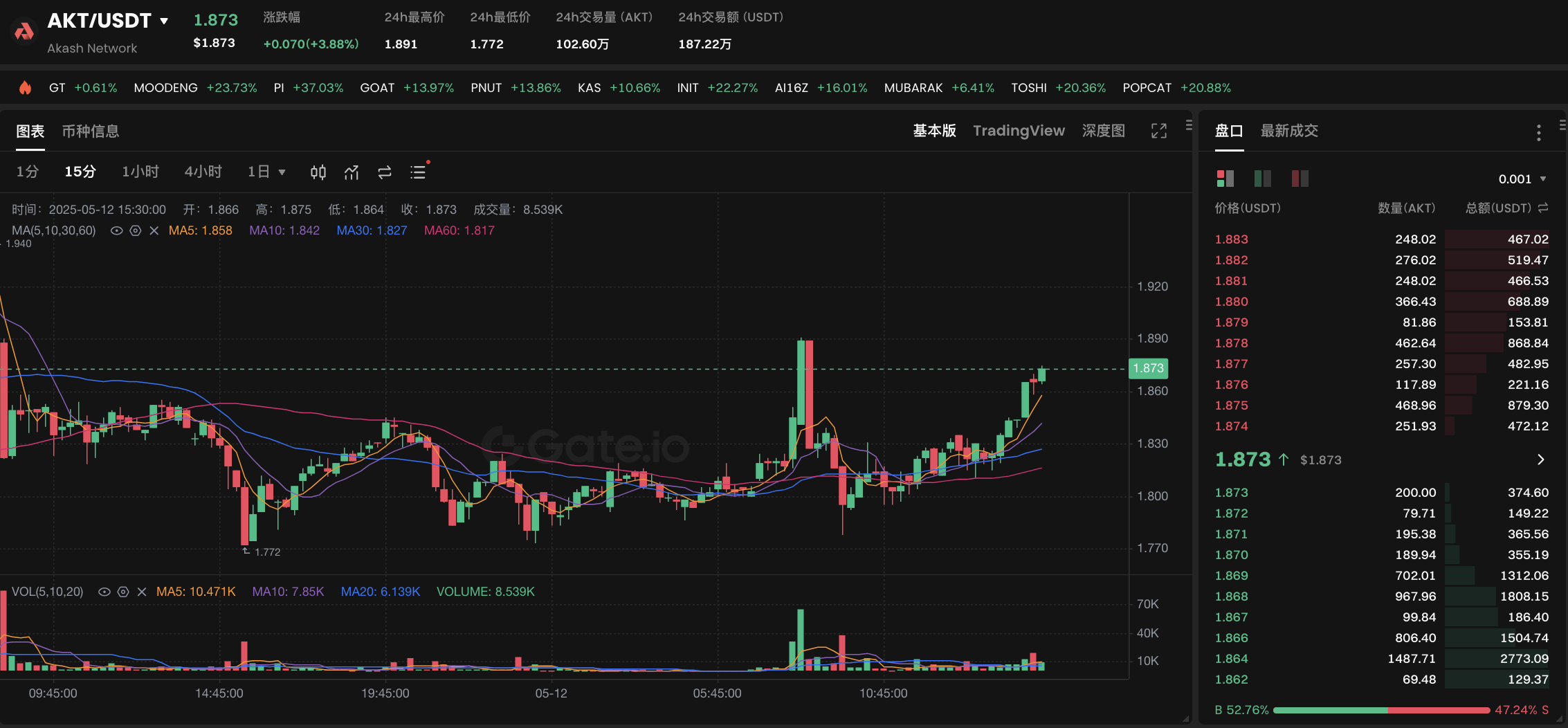什麼是 Akash Network?去中心化雲服務平台介紹
Akash Network 是什麼
Akash Network 是一個去中心化的雲計算平台,構建在 Cosmos 生態之上。它允許個人或組織將閒置的計算資源(如 CPU、GPU)出租給開發者和項目方,被譽爲“Web3 的 Airbnb”。
傳統雲計算服務(如 AWS、Google Cloud)通常價格昂貴、權限集中,而 Akash 通過區塊鏈技術和開源協議,提供了一個更加靈活、開放和成本更低的替代方案。它的核心目標是打破中心化科技巨頭對計算資源的壟斷,讓更多人能自由、高效地訪問雲計算能力。
Akash Network 的運作機制
Akash 的平台運行流程可以簡單概括爲以下四步:
供應端(Providers):任何擁有服務器資源的用戶都可以將其接入 Akash,提供 CPU/GPU 算力,並設置服務價格。
需求端(Tenants):開發者提交部署請求,包括所需資源、操作系統、運行環境等。
去中心化競價(Reverse Auction):多位供應商根據需求提交報價,系統自動選擇性價比最高的服務商。
部署與驗證:合同籤署後,應用會自動部署,相關數據通過鏈上記錄,確保透明、可信。
整個流程無須中介、自動完成,實現真正意義上的去中心化雲計算。
Akash Network:基本面與代幣經濟分析
Akash Network 的原生代幣爲 AKT,它在整個生態中扮演了核心角色,具備以下功能:
1)網路安全與質押收益
用戶可以通過質押 AKT 參與共識機制(PoS),維護網路安全。當前質押年收益率在 10%-13% 之間,非技術用戶也可通過委托給驗證人獲得獎勵。
2)治理參與
質押 AKT 可用於參與鏈上治理,如協議升級、參數調整、社區基金分配等。治理權重基於持幣數量與質押時長分配。
3)支付與資源定價
AKT 是 Akash 網路中的計價單位,部署租賃服務時默認使用 AKT 競價支付,費用較低(手續費 4%)。平台也支持穩定幣(如 USDC)支付,但手續費較高(20%),從機制上鼓勵使用 AKT。
4)通脹與銷毀機制
Akash 採用通脹模型(最高年通脹 13%),用於激勵網路參與者。手續費的一部分會被銷毀,形成一定的通縮機制,有助於長期維護代幣價值。
Akash Network 的應用場景與市場表現
Akash 不僅限於通用計算服務,其應用場景包括但不限於:
Web3 節點部署與後端服務
AI 模型推理與訓練
視頻轉碼與數據分析任務
自動化測試與開發環境(如 CI/CD)
尤其是在 AI 與 DePIN(去中心化物理基礎設施) 成爲熱點的當下,Akash 正成爲開發者部署算力密集型任務的優選平台。
圖:https://www.gate.io/trade/AKT_USDT
價格表現方面,AKT 在 2025 年 Q1 隨大盤波動,截至 5 月 10 日,價格爲 1.7 美元 左右,近期震蕩較大,投資需注意風險。
總結
Akash Network 是一個新型的去中心化雲平台,打破了傳統雲服務的中心化限制,提供更開放、可定制和成本更低的雲計算能力。它將全球閒置資源通過區塊鏈競價機制整合起來,爲 AI、Web3、DePIN 等領域提供彈性算力基礎設施。盡管其原生代幣 AKT 存在一定市場波動,但 Akash 在去中心化雲服務這一賽道中的先發優勢和持續的生態拓展,讓它成爲該領域最具潛力的項目之一。
未來,隨着去中心化計算需求的增長,Akash Network 或將扮演越來越重要的角色。但對於普通用戶而言,參與前仍需充分了解其機制與風險,理性判斷。
什麼是 Akash Network?去中心化雲服務平台介紹
Akash Network 是什麼
Akash Network 是一個去中心化的雲計算平台,構建在 Cosmos 生態之上。它允許個人或組織將閒置的計算資源(如 CPU、GPU)出租給開發者和項目方,被譽爲“Web3 的 Airbnb”。
傳統雲計算服務(如 AWS、Google Cloud)通常價格昂貴、權限集中,而 Akash 通過區塊鏈技術和開源協議,提供了一個更加靈活、開放和成本更低的替代方案。它的核心目標是打破中心化科技巨頭對計算資源的壟斷,讓更多人能自由、高效地訪問雲計算能力。
Akash Network 的運作機制
Akash 的平台運行流程可以簡單概括爲以下四步:
供應端(Providers):任何擁有服務器資源的用戶都可以將其接入 Akash,提供 CPU/GPU 算力,並設置服務價格。
需求端(Tenants):開發者提交部署請求,包括所需資源、操作系統、運行環境等。
去中心化競價(Reverse Auction):多位供應商根據需求提交報價,系統自動選擇性價比最高的服務商。
部署與驗證:合同籤署後,應用會自動部署,相關數據通過鏈上記錄,確保透明、可信。
整個流程無須中介、自動完成,實現真正意義上的去中心化雲計算。
Akash Network:基本面與代幣經濟分析
Akash Network 的原生代幣爲 AKT,它在整個生態中扮演了核心角色,具備以下功能:
1)網路安全與質押收益
用戶可以通過質押 AKT 參與共識機制(PoS),維護網路安全。當前質押年收益率在 10%-13% 之間,非技術用戶也可通過委托給驗證人獲得獎勵。
2)治理參與
質押 AKT 可用於參與鏈上治理,如協議升級、參數調整、社區基金分配等。治理權重基於持幣數量與質押時長分配。
3)支付與資源定價
AKT 是 Akash 網路中的計價單位,部署租賃服務時默認使用 AKT 競價支付,費用較低(手續費 4%)。平台也支持穩定幣(如 USDC)支付,但手續費較高(20%),從機制上鼓勵使用 AKT。
4)通脹與銷毀機制
Akash 採用通脹模型(最高年通脹 13%),用於激勵網路參與者。手續費的一部分會被銷毀,形成一定的通縮機制,有助於長期維護代幣價值。
Akash Network 的應用場景與市場表現
Akash 不僅限於通用計算服務,其應用場景包括但不限於:
Web3 節點部署與後端服務
AI 模型推理與訓練
視頻轉碼與數據分析任務
自動化測試與開發環境(如 CI/CD)
尤其是在 AI 與 DePIN(去中心化物理基礎設施) 成爲熱點的當下,Akash 正成爲開發者部署算力密集型任務的優選平台。
圖:https://www.gate.io/trade/AKT_USDT
價格表現方面,AKT 在 2025 年 Q1 隨大盤波動,截至 5 月 10 日,價格爲 1.7 美元 左右,近期震蕩較大,投資需注意風險。
總結
Akash Network 是一個新型的去中心化雲平台,打破了傳統雲服務的中心化限制,提供更開放、可定制和成本更低的雲計算能力。它將全球閒置資源通過區塊鏈競價機制整合起來,爲 AI、Web3、DePIN 等領域提供彈性算力基礎設施。盡管其原生代幣 AKT 存在一定市場波動,但 Akash 在去中心化雲服務這一賽道中的先發優勢和持續的生態拓展,讓它成爲該領域最具潛力的項目之一。
未來,隨着去中心化計算需求的增長,Akash Network 或將扮演越來越重要的角色。但對於普通用戶而言,參與前仍需充分了解其機制與風險,理性判斷。
